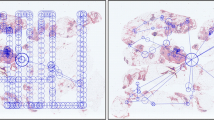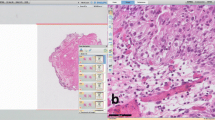Abstract
Performing diagnoses using virtual slides can take pathologists significantly longer than with glass slides, presenting a significant barrier to the use of virtual slides in routine practice. Given the benefits in pathology workflow efficiency and safety that virtual slides promise, it is important to understand reasons for this difference and identify opportunities for improvement. The effect of display resolution on time to diagnosis with virtual slides has not previously been explored. The aim of this study was to assess the effect of display resolution on time to diagnosis with virtual slides. Nine pathologists participated in a counterbalanced crossover study, viewing axillary lymph node slides on a microscope, a 23-in 2.3-megapixel single-screen display and a three-screen 11-megapixel display consisting of three 27-in displays. Time to diagnosis and time to first target were faster on the microscope than on the single and three-screen displays. There was no significant difference between the microscope and the three-screen display in time to first target, while the time taken on the single-screen display was significantly higher than that on the microscope. The results suggest that a digital pathology workstation with an increased number of pixels may make it easier to identify where cancer is located in the initial slide overview, enabling quick location of diagnostically relevant regions of interest. However, when a comprehensive, detailed search of a slide has to be made, increased resolution may not offer any additional benefit.






Similar content being viewed by others
References
Li X, et al: A feasibility study of virtual slides in surgical pathology in China. Hum Pathol 38:1842–1848, 2007
Velez N, Jukic D, Ho J: Evaluation of 2 whole-slide imaging applications in dermatopathology. Hum Pathol 39:1341–1349, 2008
Treanor D, Jordan-Owers N, Hodrien J, Wood J, Quirke P, Ruddle RA: Virtual reality Powerwall versus conventional microscope for viewing pathology slides: an experimental comparison. Histopathology 55:294–300, 2009
Randell R, Ruddle RA, Mello-Thoms C, Thomas RG, Quirke P, Treanor D: Virtual reality microscope versus conventional microscope regarding time to diagnosis: an experimental study. Histopathology 62:351–358, 2013
Gur D, et al: The Effect of Image Display Size on Observer Performance: An Assessment of Variance Components. Acad Radiol 13:409–413, 2006
Bessho Y, Yamaguchi M, Fujita H, Azuma M: Usefulness of Reduced Image Display Size in Softcopy Reading: Evaluation of Lung Nodules in Chest Screening. Acad Radiol 16:940–946, 2009
D’Haene N, et al: Comparison study of five different display modalities for whole slide images in surgical pathology and cytopathology in Europe. Proceedings of SPIE, Florida, USA, 2013. doi:10.1117/12.2001594
Sharma G, et al: Evaluation of different display modalities for whole slide images in pathology. J Pathol Inform 2: S44–45, 2011
Ball R, North C, Bowman DA: Move to improve: promoting physical navigation to increase user performance with large displays. Proceedings of the SIGCHI Conference on Human Factors in Computing Systems. ACM, New York, USA, 2007, pp 191–200
Ball R, North C: The effects of peripheral vision and physical navigation on large scale visualization. Proceedings of Graphics Interface, Canadian Information Processing Society Toronto, Canada, 2008, pp 9–16
Ruddle RA, et al. E: Performance and interaction behaviour during visual search on large, high-resolution displays. Information Visualization, 2014. doi:10.1177/1473871613500978
Têtu B, Evans A: Canadian Licensure for the Use of Digital Pathology for Routine Diagnoses. Arch Pathol Lab Med 138:302–304, 2014
Hamilton PW, Wang Y, McCullough SJ: Virtual microscopy and digital pathology in training and education. APMIS 120:305–315, 2012
Ramey J, Fung KM, Hassell LA: Use of mobile high-resolution device for remote frozen section evaluation of whole slide images. J Pathol Inform 2, doi:10.4103/2153-3539.84276, 2011
Sibbald B, Roberts C: Understanding controlled trials. Crossover trials. BMJ 316:1719–1720, 1998
Field A: Discovering statistics using SPSS. Sage, London, 2009
Nodine CF, Kundel HL: The cognitive side of visual search in Radiology. Elsevier, Amsterdam, 1987
Drew T, Evans K, Võ ML-H, Jacobson FL, Wolfe JM: Informatics in Radiology: What Can You See in a Single Glance and How Might This Guide Visual Search in Medical Images? Radiographics 33:263–274, 2013
Wolfe JM, Võ MLH, Evans KK, Greene MR: Visual search in scenes involves selective and nonselective pathways. Trends Cogn Sci 15:77–84, 2011
Krupinski EA, et al: Eye-movement study and human performance using telepathology virtual slides. Implications for medical education and differences with experience. Hum Pathol 37:1543–1556, 2006
Krupinski EA, Graham AR, Weinstein RS: Characterizing the development of visual search expertise in pathology residents viewing whole slide images. Hum Pathol 44:357–364, 2013
Acknowledgments
We are very grateful to the pathologists at Leeds Teaching Hospitals NHS Trust who participated in this experiment. We would also like to thank Mike Hale, Dave Turner and Steve Thoms for their assistance in setting up various aspects of this evaluation and Preetha Chengot for her assistance with the photography. This report is independent research commissioned by the National Institute for Health Research (NIHR) under the New and Emerging Applications of Technology (NEAT) programme. The authors acknowledge the support of the NIHR, through the Comprehensive Clinical Research Network.
Conflict of interest
The views expressed in this publication are those of the authors and not necessarily those of the NHS, the NIHR or the Department of Health.
Author information
Authors and Affiliations
Corresponding author
Rights and permissions
About this article
Cite this article
Randell, R., Ambepitiya, T., Mello-Thoms, C. et al. Effect of Display Resolution on Time to Diagnosis with Virtual Pathology Slides in a Systematic Search Task. J Digit Imaging 28, 68–76 (2015). https://doi.org/10.1007/s10278-014-9726-8
Published:
Issue Date:
DOI: https://doi.org/10.1007/s10278-014-9726-8




